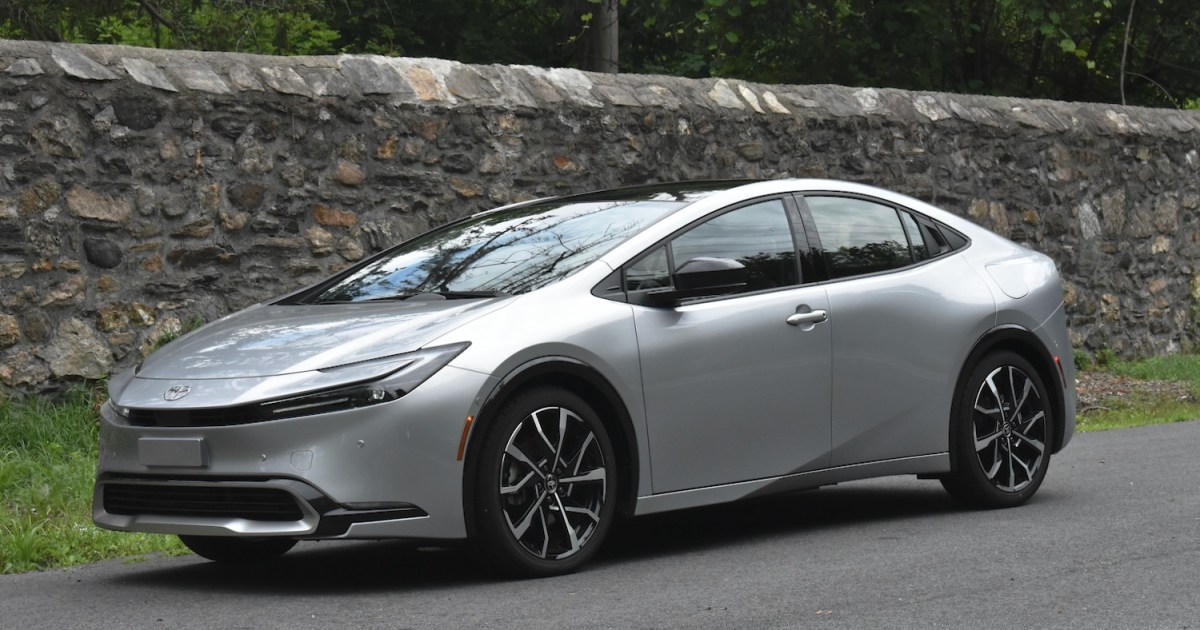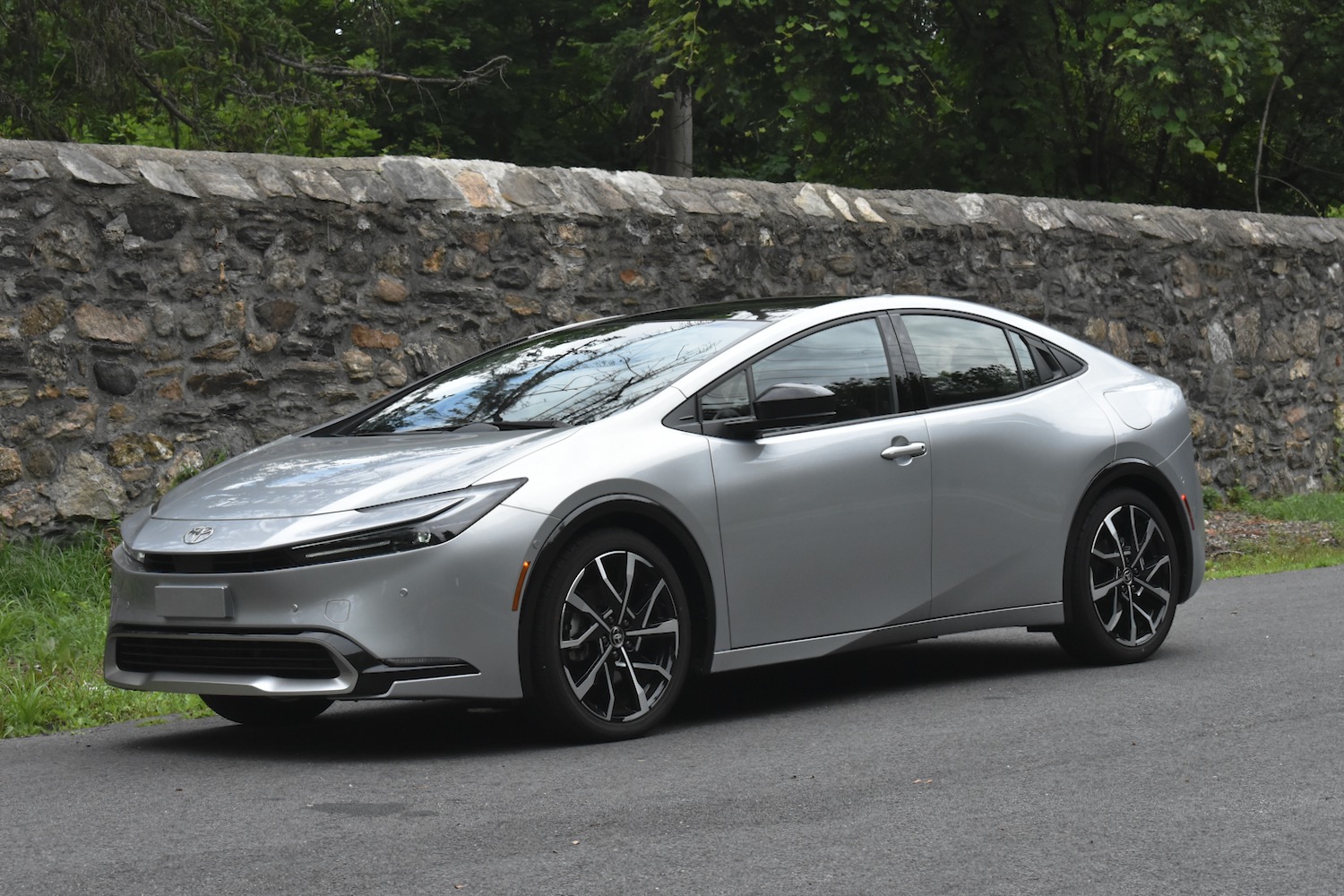
2023 Toyota Prius Prime
MSRP $33,445.00
“The redesigned Prius Prime has more of everything you need in a plug-in hybrid, in a more attractive package.”
Pros
- Stunning redesign
- Improved infotainment system
- Impressive electric range
- Still fairly practical
Cons
- Low-rent interior
- Underwhelming tech options
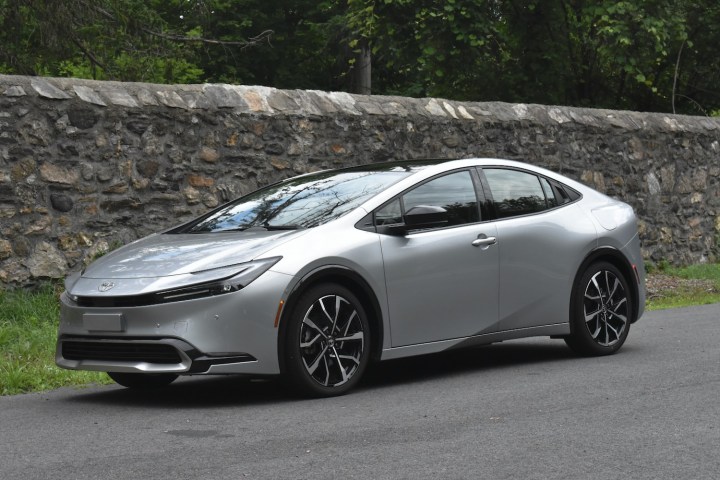
The Toyota Prius is one of the most important cars in automotive history, but it’s never been one of the most desirable. Toyota aims to change that with a redesign of the iconic hybrid.
The Prius has always had unorthodox styling, but the redesigned 2023 model is the first Prius that might actually be called good-looking. And once again, there is a Prius Prime plug-in hybrid model that shares styling with the standard Prius, but also helps bridge the gap between conventional hybrids and all-electric vehicles.
Like other plug-in hybrids, the 2023 Toyota Prius Prime can be charged by plugging in, meaning it can have a bigger battery pack that delivers substantial all-electric range. For 2023, that added capability comes at a $4,900 premium over the cheapest standard Prius. Pricing starts at $33,445 for the base Prius Prime SE and rises to $36,695 for the mid-tier XSE. Our fully loaded XSE Premium test car had a sticker price of $42,510 with options.
Design and interior
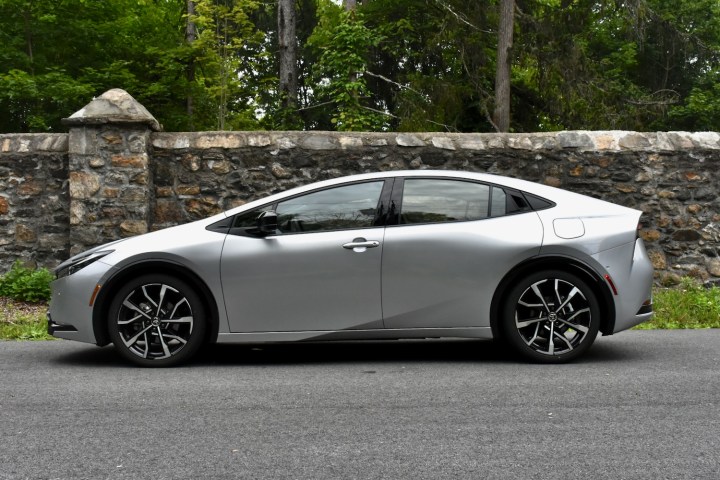
The 2023 Prius Prime is the third generation of plug-in hybrid Prius, but the model has had a convoluted development. The first version was badged Prius Plug-In Hybrid and looked identical to the standard Prius. The Prime name was introduced with the outgoing second generation, which also got unique styling. With Prime now Toyota’s default designation for plug-in hybrid versions of existing models, like the RAV4 Prime, the new version once again shares styling with the standard Prius. That’s definitely a good thing.
No car in recent years has gotten a makeover like the Prius. It starts with the profile. The windshield is laid back at a supercar-like angle, the roof is low, and the tail is chopped off. This not only helps reduce aerodynamic drag, but gives the new models a silhouette reminiscent of a 1970s Lotus Esprit — one with four doors and a rear hatch, that is.
The sleeker silhouette is complemented by improved proportions. The wheels are closer to the corners of the body than before, eliminating the overhangs that made the previous-generation Prius and Prius Prime look ungainly. Unlike those models, Toyota designers also resisted the urge to apply excessive detailing, giving the new models a cleaner look.
No car in recent years has gotten a makeover like the Prius.
Inside, Toyota ditched the weird central instrument cluster from the previous-generation Prius Prime, but replaced it with the unit from the all-electric Toyota bZ4X. It’s positioned in front of the driver, but very far forward on the dashboard, meaning drivers of certain heights will have their view partially blocked by the steering wheel. And while the low-slung seating position makes you feel like you’re in a sports car, the interior materials don’t. Even our top XSE Premium example looked like a basic economy car on the inside. Toyota isn’t kidding itself. As stylish as they are on the outside, the automaker knows many of these cars will end up as taxis and rideshare vehicles.
Interior space doesn’t change much, at least. Headroom decreases slightly from the previous-generation Prius Prime, but front-seat legroom is identical, and there’s actually a bit more rear-seat legroom. The 2023 Prius Prime’s maximum 23.8 cubic feet of cargo capacity is also a useful 4.0 cubic feet greater than in the outgoing model.
Most other plug-in hybrids from mainstream brands are crossover SUVs like the Mitsubishi Outlander PHEV or Toyota’s own RAV4 Prime, making for an apples-to-oranges comparison when it comes to interior space. The Kia Niro PHEV has some SUV-like styling cues, but ends up being pretty close to the sleeker Prius Prime, with a slightly more headroom and additional rear-seat legroom, but less cargo space.
Tech, infotainment, and driver assist

The last Prius Prime dated back to the 2017 model year, so a tech update was definitely needed. The 2023 Prius Prime scraps the old model’s portrait infotainment touchscreen for an 8.0-inch (12.3 inches on higher trim levels) landscape-oriented version. A 7.0-inch digital instrument cluster is standard as well, along with wireless Apple CarPlay/Android Auto connectivity and six USB ports.
The infotainment system is one of Toyota’s latest, and that makes a big difference. The old system was merely adequate when new, and its primitive graphics aged quickly. The new system not only looks sharper, but adds helpful features like a menu bar for the main touchscreen and improved voice recognition that responds to casual speech. The main screen is also easier to navigate thanks to a helpful menu bar, and Toyota replaced the old Prius Prime’s touchpad controls with more substantial-feeling buttons and knobs.
The infotainment system is one of Toyota’s latest, and that makes a big difference.
Upgrading to the top XSE Premium grade nets digital-key functionality, but even on this model, a digital rearview mirror is a $200 option. This feature, which shows a rearview camera feed in the mirror housing, has been available from automakers like General Motors and Nissan for some time, and isn’t really necessary here because of the Prius Prime’s generously sized rear window.
The Prius Prime does get the expected array of driver-assist features as standard equipment, including forward collision warning, automatic emergency braking, lane departure warning, adaptive cruise control, traffic sign recognition, and automatic high beams. Blind-spot monitoring, rear cross-traffic alert, and park assist are optional, along with a Traffic Jam Assist system that enables hands-free acceleration, steering, and braking in stop-and-go traffic (it only works up to 25 mph). It requires a subscription to Toyota’s Drive Connect telematics plan, however.
Driving experience

The redesign brings improved performance as well. The gasoline four-cylinder engine’s displacement grows from 1.8 liters to 2.0 liters, while battery capacity increases from 8.8 kilowatt-hours to 13.6 kWh. The Prius Prime is still available only with front-wheel drive, though, lacking the all-wheel drive option of the standard Prius.
Total system output is now 220 horsepower, compared to 121 hp before. The added power is apparent in Toyota’s zero-to-60 mph estimate, which plunges from the previous 10.2 seconds to 6.6 seconds. That’s still not super quick, but it’s enough to break the old Prius stereotypes.
In addition to no longer being a liability on highway on-ramps, the Prius Prime behaves more like an electric car than a hybrid. Unlike some plug-in hybrids, it’s possible to drive with the normal flow of traffic without kicking on the gasoline engine. There’s enough electric power to handle most accelerative needs. It’s a very pleasant to drive this way because, while the blend of gasoline and electric power in hybrid mode is well-executed, it can’t match the smoothness of all-electric driving.
It’s still not super quick, but breaks the old Prius stereotypes.
The Prius Prime is no sports car, but it doesn’t get discombobulated in corners either. The chassis tuning strikes a good balance between preventing the body from flopping around when the car changes direction and absorbing impacts to spare occupants’ internal organs. Everything happens at a relaxed pace — this is not a car that encourages you to charge into corners — but the new Prime exceeds the (admittedly low) expectations for Prius driving dynamics.
Gas mileage, electric range, and safety
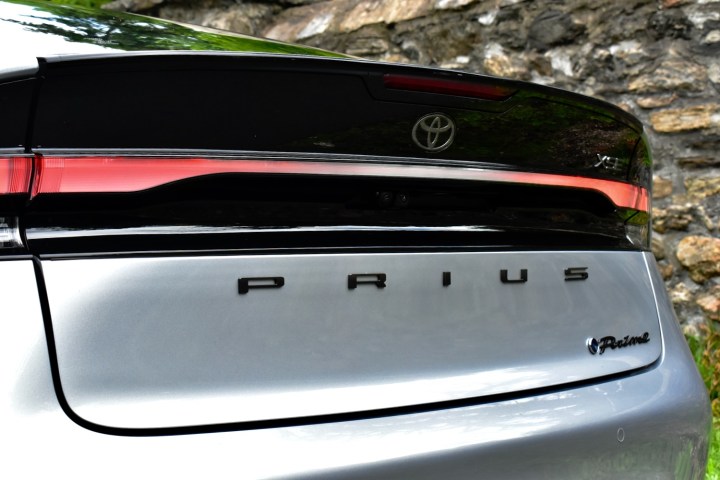
Official ratings aren’t in yet, but Toyota estimates the 2023 Prius Prime will manage up to 44 miles of range in base SE form and 39 miles in XSE and XSE Premium specs. That’s a big improvement over the 2022 model’s 25 miles, although fuel economy in hybrid mode is expected to drop slightly, from 54 mpg combined to 52 mpg combined.
The Prius Prime is also available with a solar roof that can help charge the battery pack while parked, but we found it only helps a little. After six hours parked in continuous sunlight, the car registered just 2.7 additional miles of electric range from solar charging. Charge the conventional way, and you’re looking at four hours to a full battery when using a 240-volt Level 2 AC charging station (the Prius Prime isn’t available with DC fast charging) or 11 hours using a 120-volt household outlet.
The Insurance Institute for Highway Safety (IIHS) and National Highway Traffic Safety Administration (NHTSA) haven’t published crash-test ratings for the redesigned Prius Prime or the standard Prius, but we do know that warranty coverage will carry over. Prime models get the same three-year, 36,000-mile basic warranty; eight-year, 100,000-mile hybrid component warranty; and 10-year, 150,000-mile battery warranty as other Toyota hybrid models.
How DT would configure this car
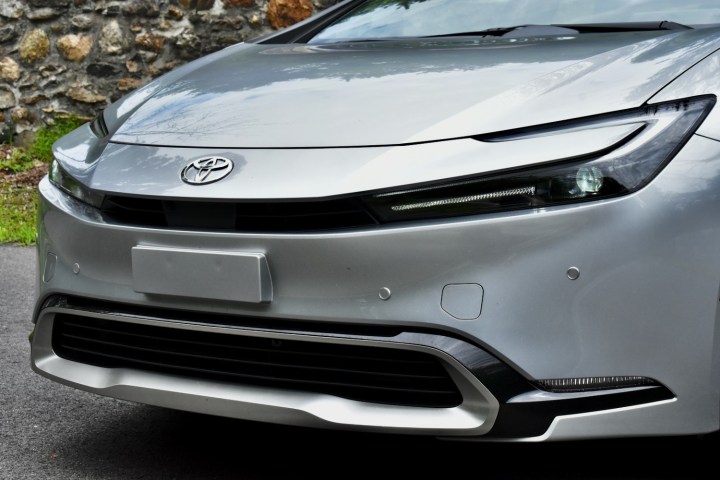
Getting the best tech value means sacrificing a few miles of estimated electric range and upgrading from the base Prius Prime SE to the XSE, then adding the optional 12.3-inch touchscreen and, if it seems like something you will actually use, digital key functionality. With those options, a Prius Prime XSE is listed at $37,430, or $1,740 less than the base price of the top Prius Prime XSE Premium, which gets the bigger screen and digital key as standard equipment. From a tech perspective, the main benefit of the XSE Premium is being able to add the solar roof and digital rearview mirror for an additional $610 and $200, respectively, but we found these features didn’t really add much to the experience.
Regardless of how it’s outfitted, the 2023 Toyota Prius Prime is a breath of fresh air for plug-in hybrids. The trend lately has been to make plug-in hybrid versions of popular SUVs, like the Toyota RAV4 Prime, Ford Escape, Hyundai Tucson, and Kia Sportage plug-in hybrids. The Mitsubishi Outlander PHEV adds more EV-like behavior to this formula. The Kia Niro PHEV tries to split the difference between car and SUV, watering down whatever impact its outlandish styling might otherwise have.
Instead of fretting over what will make customers more likely to accept a plug-in hybrid, Toyota simply tried to make the best Prius Prime it could. It may not be an SUV, but the Prius Prime sports a handsome design that stands out. It’s also functional, boasting more electric range, more cargo space, and an easier-to-use infotainment system. It tries to win you over — and succeeds — by just being a good car.
The Prius was once the last word in green tech, but was overshadowed by EVs. Toyota has struggled to make its signature vehicle relevant again, and this time it’s finally figured out how.
Editors’ Recommendations

